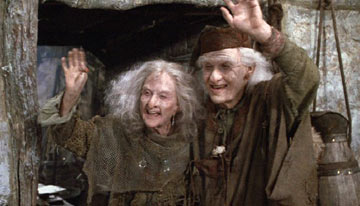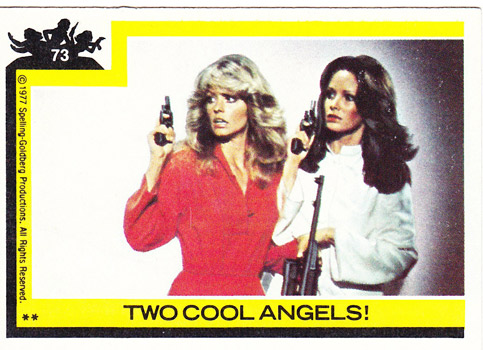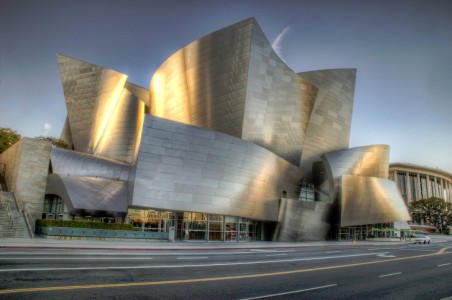"I hopped off the plane at LAX
With a dream and my cardigan
Welcome to the land of fame excess (Whoa), am I gonna fit in?
Jumped in the cab here I am for the first time
Look to my right and I see the Hollywood sign
This is all so crazy, everybody seems so famous"
But seriously.
What is it about California, LA in particular, that represents such a fantasy, such an optimism, such suspicion?
The specifics of the culture were identifiable in literature by such figures as Jack London, Amy Tan, Mark Twain, John Steinbeck, and Aldous Huxley. Of course, if we want to be topical, we can also look at its' influence on fictional figures, like Don Draper, who see it as a gleaming example of hope and nostalgia wrapped in a neat package.
In many ways, California is microcosm of how the United States presents itself, which make sense, as much of our media (or propaganda if you want to use a loaded word) is produced.
The assessment is as such: California, like America, has the following traits:
- Optimistic
- Clever
- Brave
- Heartfelt
- Curious
- Adventuresome
- Idealistic
- Charming
It also has the faults of being:
- Shallow
- Self-hating
- Youth-Obsessed
- Narcissistic
- Overly Competitive
- Arrogant
- Egotistical
- Ridiculous
The architecture of Los Angeles, much like the literature, reflects this fascinating paradox. Let's look at some examples, shall we?
Part I: You can always go home, it just can't be yours.
While I was in LA, three people became the center of my residential focus. That is, The Eames and John Lautner.
Charles and Ray were a couple the likes of which are enviable. Charles began his career in steel and was entranced by Scandinavian modernity, Ray was a sophisticated artist and designer who could more than keep up with her husband. Where Charles could envision the space, Ray could make it come alive.
In their work, there is the pursuit of a better kind of life through what the west has to offer, that is, open space. Case Study House #8 is a great example.
Though it took longer for the materials to arrive then it did to assemble everything (several years vs. two days), The Eames were forever figuring out how their home would be arranged. This process is extremely different from Frank Lloyd Wright or Le Corbusier, who had very strict ideas as to how their spaces were going to be lived in.
Charles and Ray were continually deciding what would be in the grand living room. This room serves as garden, library and tea room all at once. The search for reinvention and change physically manifests itself while loving the landscape. Originally the plan was to have the house stand over the meadow that it is now adjacent to. The Eames moved this back in order to better preserve what they loved about the space, the openness.
Dominating the landscape makes sense in say, Fallingwater, where the effect is dramatic, or (though I have yet to see it in person) the Farnsworth house, where the look is one of delicate removal, but in something as (dare I say it) fun as the Eames house, it would look a little pompous.
For videos of this house, see the previous post
On the other hand is John Lautner, who can do a lot more name dropping with his LA homes, as they have appeared in tons of movies.
(Ok that last one is different. but next time you watch it, check out Jackie Treehorn's pad)
John Lautner, believed in nature, much like the Eames. However, while the Eames were steeped in a mixture of DeStijl and Bauhaus traditions, Lautner was a zealous disciple of Frank Lloyd Wright. In addition to this, he was a promoter of the Gaia Movement's dogma of "Organic Architecture". The commandments of which are:
"Let the design:
be inspired by nature and be sustainable, healthy, conserving, and diverse.
unfold, like an organism, from the seed within.
exist in the "continuous present" and "begin again and again".
follow the flows and be flexible and adaptable.
satisfy social, physical, and spiritual needs.
"grow out of the site" and be unique.
celebrate the spirit of youth, play and surprise.
express the rhythm of music and the power of dance."
Specific, yet open to interpretation.
Lautner both loves and controls the nature of his homes. The palm trees are dynamic, but do not overshadow the sharp edges of the concrete. There is also the glass, always with the glass.
Lautner's architecture became popular a little bit later than the Eames and visually you can tell. The Eames seem to be a 1950s-early 60s dream, while Lautner has more grander, something that seems unmistakably late 60s-70s.
So, where the Eames Case Study houses seem like the humble experiments of a kindly couple out in the woods.

Lautner's designs are how can we put this? Sexier. They just ooze money, sophistication and a sultry kind of power.

To sum it up: you want to marry the Eames Designs, but have an affair with the Lautner Designs.
These three designers were a product of their respective times yet simultaneously a reaction to the core cultures of LA, which are in short: a dependence of cars, modernity and convenience. These three things more than anything else lead to what? Say it with me folks. Pollution. So they straddle the needs of their modern life with a reverence for nature. Like a more moral kind of Petit Trianon.
There are a number of other great homes in LA, designed by the likes of Greene & Greene, Schindler, Neutra, Wright, but for the sake of time. We'll move on.
An example of a few more can be found here
Part II: Uptown v. Downtown: The Public Buildings Strike Back
There are a lot of great museums in LA. In particular I like the MOCA and LACMA
However, there are two rival buildings which have high visual concepts.
Firstly to divert from our path, I love the architectural debates going on right now. They're complicated. Studying older architectural history, there is a chronological order to how things go, a natural progression. German Cathedrals are different from Italian ones, and for very specific reasons. They also take decades, if not centuries to build, so most of the time there is less personal vision.
Currently, there are so many requirements and agendas happening at the same time that it creates greater challenges for architects, and I believe more often than not, fascinating results.
The computer allows architects to put a ton of personality into their work, which means that when you're buying a design, you're buying an architect. The viewpoint included. So it is with that we look at the following two designs.
The Getty Center and the Walt Disney Concert Hall.

The Getty Center was designed by Richard Meier, a rationalist architect who is part of that boy band known as "The New York Five". The Getty, like much of Meier's work has this sense of formality to it. When you get there, you have arrived. The best example of this is when I was reading the map and misread the title page.
It listed the "Arrival Court" however I saw it as "Arriving at Court" and I think it accurately summed up the feeling.
The museum design invokes the Parthenon, both in its layout of the individual structures and the procession and walk through process that it orchestrates. Meier is saying "you don't HAVE to, but you should do it this way". The museum is much like the collection, a few break out stars, a lot of pretty good and nothing uninteresting.
What you get the most of in this design, besides the view, is the texture. Soft to hard, delicate to rough, steel to stone, it's a mastery of what the material can do. I've given Meier a hard time in the past, mostly for his work at the Ara Pacis.
However, that work represented the "Californication" of Europe. We're in LA now baby, and here it just makes sense.
Also, it should be noted I arrived on the one day, it seems ever, it was raining at the Getty. They were kind enough to give you an umbrella as you get off the tram, which was thoughtful, but did present a huge design flaw.
Next we have the Walt Disney Concert Hall which, like the Getty, is dramatic and charming. But it is there the similarities end.

Where Meier is considered one of the elites, seemingly bred for a sleek kind of architecture by the all-powerful Philip Johnson, Gehry is someone with whom you just fall in love. He's the underdog, the one you want to believe in, if we want to be cliche about it... the Hollywood story.
By his own testimony:
“I was a truck driver in L.A., going to City College, and I tried radio announcing, which I wasn't very good at. I tried chemical engineering, which I wasn't very good at and didn't like, and then I remembered. You know, somehow I just started racking my brain about, "What do I like?" Where was I? What made me excited? And I remembered art, that I loved going to museums and I loved looking at paintings, loved listening to music. Those things came from my mother, who took me to concerts and museums. I remembered Grandma and the blocks, and just on a hunch, I tried some architecture classes.”
Now that may seem romantic, but when you look at the WDCH, you get it. Where the Getty is an implied progression from space to space, the Concert Hall is an exploration of the nooks and crannies that the curves create.
However, it is not without it's critics. Let's get real for a moment, It's a mess of a building with angles and curves everywhere that don't make any sense. THEY JUST DON'T.
Or do they?
They make sense if you think like a painter or a sculpture. It's not just about the space or the program, it's about the mere shock of it all. Like walking in on an enormous painting.
It's got that "Wow" Factor. That nothingness that is tangible and unobtainable, like charm without the smarm, with goodness without condescension, so hard to achieve yet instantly recognizable.
At the Getty, you are a pilgrim to worship the art. At the WDCH you're a spelunker there to discover it. Some would argue that is the nature of the art you are there to see, visual vs. acoustic, but that may be taking it too literally.
Part III: The Greening
We can't end this post without talking about the green elephant in the room, which is of course, Sustainability. California, more than anywhere else in the US is obsessed with the environmental aspects of it's construction. For good reason.
The basic infrastructure of LA is counter intuitive to everything the green movement stands for. (Just watch the end of 'Who Framed Roger Rabbit'.) You need a car. You just do. The shining kind of optimism that makes the area so appealing is the exact same thing that makes it unsustainable. So, with all the sincerity of a born again convict, LA is interested in health and the environment.
Maybe it's because I'm a cynical Easterner with a heart of coal who is impatient, rude, and demanding but I can't understand a city without a public transit system that works well (and I lived in Philadelphia).
What you need is a rail system, a good one. What you have are highways and a tourist line. Will installing it be a pain in the butt? Yes. You need it. Think of it as "having some work done."
It should be noted they're working on the Metro solution, but the TBDs leave one a little nervous.
Coming soon to a Metropolitan area near you
Finally, because we talked so much about the future past, enjoy one of my favorites:
Also, a special thanks to my hosts. They were lovely and charming.
You can catch their webseries here:
CouchSurfersTV



No comments:
Post a Comment